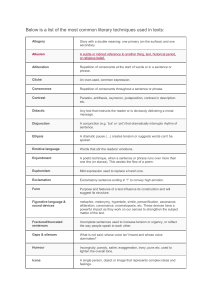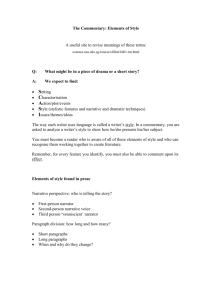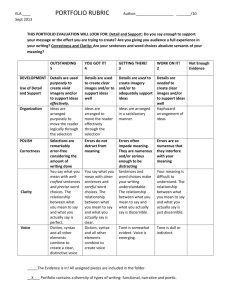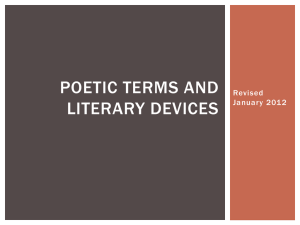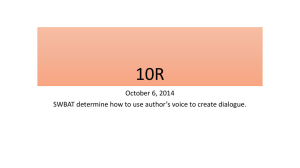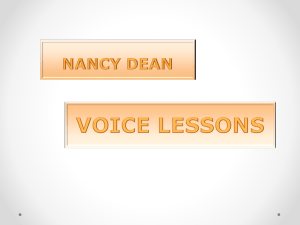Dramatic Techniques Glossary
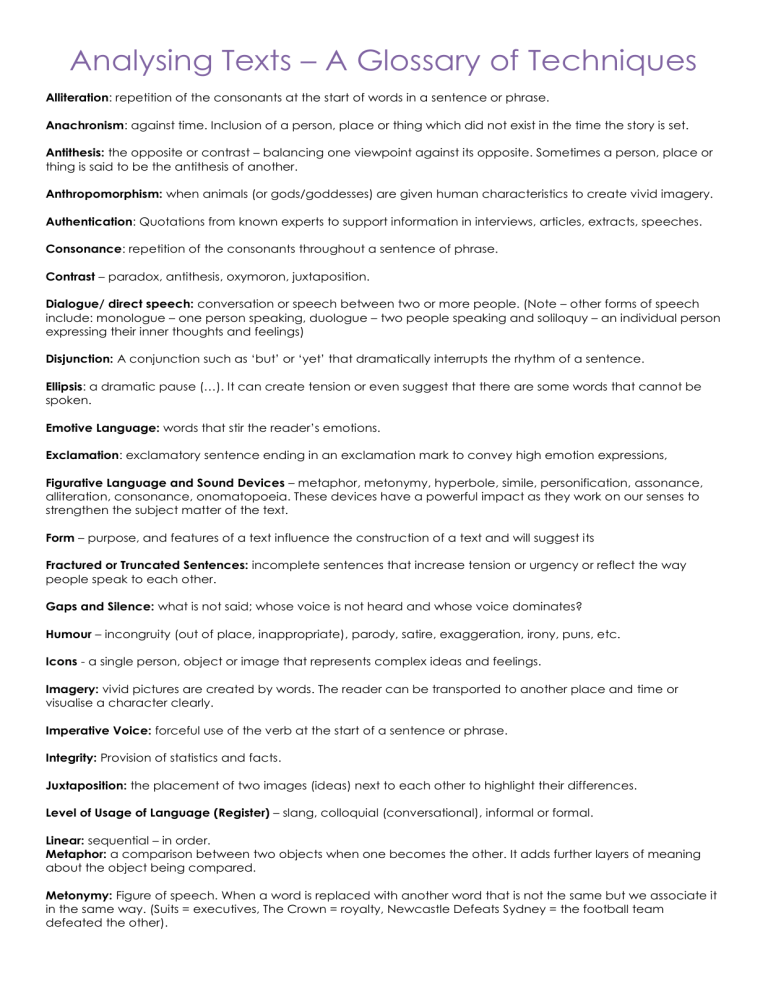
Analysing Texts – A Glossary of Techniques
Alliteration: repetition of the consonants at the start of words in a sentence or phrase.
Anachronism: against time. Inclusion of a person, place or thing which did not exist in the time the story is set.
Antithesis: the opposite or contrast – balancing one viewpoint against its opposite. Sometimes a person, place or thing is said to be the antithesis of another.
Anthropomorphism: when animals (or gods/goddesses) are given human characteristics to create vivid imagery.
Authentication: Quotations from known experts to support information in interviews, articles, extracts, speeches.
Consonance: repetition of the consonants throughout a sentence of phrase.
Contrast – paradox, antithesis, oxymoron, juxtaposition.
Dialogue/ direct speech: conversation or speech between two or more people. (Note – other forms of speech include: monologue – one person speaking, duologue – two people speaking and soliloquy – an individual person expressing their inner thoughts and feelings)
Disjunction: A conjunction such as ‘but’ or ‘yet’ that dramatically interrupts the rhythm of a sentence.
Ellipsis: a dramatic pause (…). It can create tension or even suggest that there are some words that cannot be spoken.
Emotive Language: words that stir the reader’s emotions.
Exclamation: exclamatory sentence ending in an exclamation mark to convey high emotion expressions,
Figurative Language and Sound Devices – metaphor, metonymy, hyperbole, simile, personification, assonance, alliteration, consonance, onomatopoeia. These devices have a powerful impact as they work on our senses to strengthen the subject matter of the text.
Form – purpose, and features of a text influence the construction of a text and will suggest its
Fractured or Truncated Sentences: incomplete sentences that increase tension or urgency or reflect the way people speak to each other.
Gaps and Silence: what is not said; whose voice is not heard and whose voice dominates?
Humour – incongruity (out of place, inappropriate), parody, satire, exaggeration, irony, puns, etc.
Icons - a single person, object or image that represents complex ideas and feelings.
Imagery: vivid pictures are created by words. The reader can be transported to another place and time or visualise a character clearly.
Imperative Voice: forceful use of the verb at the start of a sentence or phrase.
Integrity: Provision of statistics and facts.
Juxtaposition: the placement of two images (ideas) next to each other to highlight their differences.
Level of Usage of Language (Register) – slang, colloquial (conversational), informal or formal.
Linear: sequential – in order.
Metaphor: a comparison between two objects when one becomes the other. It adds further layers of meaning about the object being compared.
Metonymy: Figure of speech. When a word is replaced with another word that is not the same but we associate it in the same way. (Suits = executives, The Crown = royalty, Newcastle Defeats Sydney = the football team defeated the other).
Mise-en-scene: what is placed in the scene by the director such as: lighting, choice of actors, props and composition.
Modality: the force the words are delivered at. High modality is forceful and low modality is gentle.
Non-Linear: non-sequential (not in sequence) narrative.
Onomatopoeia: a word that echoes the sound it represents. The reader can hear what is happening in the scene.
Oxymoron: the contradiction between two words in close connection, “parting is such sweet sorrw”.
Paradox: a seemingly contradictory statement that contains a truth or opinion, “ you have to be cruel to be kind”.
Person: 1st (I or we), 2nd (you) or 3rd (he, she or they) (Note – also omniscient narration – all-seeing)
Personification: giving human characteristics to a non-human. Inanimate objects take on a life of their own.
Perspective: a way of looking at individuals, issues, events, texts, facts.
Plosive Consonants: using harsh sounds in a sentence or phrase.
Repetition: of words or syntax (order of words) for emphasis and persuasion
Representation: how a composer conveys meaning through textual features and details.
Rhetorical Devices: used to persuade an audience - cumulation (lists), rhetorical questions, imperatives
(commands), repetition.
Sensory Imagery: appealing to the senses of the responder. (SSSTT) Sight = visual imagery, smell = olfactory imagery, sound = aural imagery, touch = tactile imagery, taste = gustatory imagery.
Setting: location of a story – internal and external.
Sibilance: repetition of the consonant ‘s’ – can make a line sound melodious and sweet or cold and icy.
Simile: when two objects are compared using ‘like’ or ‘as’.
Symbolism: When an object stands for one or more ideas.
Syntax: Sentence structure - short, simple sentences or truncated (fractured) sentences create tension, haste or urgency; compound or complex sentences are slower and often feature in a formal text
Tense: present tense – set in the present. Past tense – set in the past. Future tense – the events are predicted.
Theme: message or moral of a story. Themes make us ponder the big issues in life.
Tone: the way the composer or character feels – conveyed by the composer’s choice of
Visual Devices: composition, angle, framing, positioning, orientation, body language, facial expression gestures, lighting, contrast, point of view, symbolism, omissions, colour, gaze, vectors and rule of thirds.
Word Choice or Diction: verbs, nouns, adjectives, words with positive/ negative connotations - emotive, forceful, factual, descriptive, blunt, graphic, disturbing, informative. Eg The writer’s use of forceful verbs such as ‘insist’ and
‘demand’ can be very persuasive.
